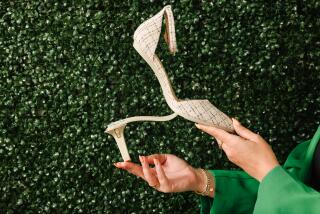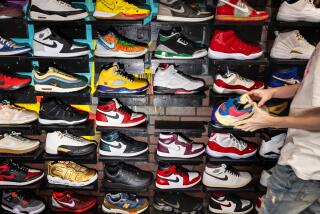NEARLY NAKED
If you live in Los Angeles or other fashion-forward places where people are eager to try new things, you have seen them: people running around in shoes that look like gorilla feet, modern ninja footwear or high-tech surf booties.
They are the newest twist on the oldest walking technology on Earth: feet.
With major shoe companies releasing a slew of these so-called barefoot shoes onto the market this spring, what began as a small movement among hard-core runners is edging into the mainstream. People are buying the minimalist shoes to hike, walk, lift weights, cross-train and water their lawns.
“It is like wearing little hobbit feet,” said 42-year-old Hollywood screenwriter Matthew Sand, who wears his barefoot shoes to walk his pit bull. “It feels like walking barefoot across the grass when you were a kid, but also high-tech and cool. It is both the future and the past wrapped up with me and my toes.”
The explosion in funky footwear that promises stronger muscles and better posture has some wondering whether these barefoot shoes are merely a passing fad -- the Earth shoe of the 21st century -- or something more lasting in the ever-expanding sports-shoe continuum.
“More than a trend, they are going to be a new category of shoe for workout enthusiasts,” said Linda Sparling, general manager for FrontRunners, a longtime fitness retailer in Brentwood. “But yes, when they first came in, we had them sitting with the Earth shoes.”
The most distinctive of the barefoot shoes is the FiveFingers, the individual-toed bootie with a 2-millimeter rubber sole that was dreamed up by Vibram, the renowned Italian company best known for making high-performance rubber soles for hiking boots. The patented design was introduced in 2006 and marketed for kayaking and sailing. But the shoes became a hit among barefoot runners.
The privately held company doesn’t release exact sales figures, but Vibram is on track to sell 10 times more barefoot shoes this year than it did in 2009, said Georgia Shaw, marketing director for Vibram USA.
The success of FiveFingers has spawned a new generation of barefoot shoes that are less weird-looking -- they lack individual slots for each toe -- but are still light and low to the ground:
* New Balance just released the Minimus collection, with shoes for trail, road and life, accompanied by the motto “<=>” (that’s roughly “less equals more,” for the mathematically challenged).
* Merrell, which makes hiking shoes and sandals, introduced its Barefoot Collection in March with shoes that promise to strengthen, realign and stimulate your feet.
* Fila’s Skele-toes minimalist shoes evoke the original FiveFingers, but they have only four toe compartments (the last two toes slide in together). Fila promotes them “for just about everywhere” but specifically not for running.
Those who believe in barefoot shoes contend the footwear uses the body’s natural biomechanics to strengthen the calf, core and foot muscles, change one’s gait and improve posture. By taking the foot out of the “cast” of a regular shoe, the barefoot shoes improve the range of motion of ankles and feet. Unshielded by the thick, padded soles of running shoes, receptors in the feet receive information about surfaces and slopes, training the body to respond with balance and agility. And by eliminating the heel lift, body weight is distributed across the entire foot, promoting spinal alignment.
“I do not think it is just a flash in the pan,” says Dr. Peter Langer, a podiatrist in Minneapolis and a self-described “shoe geek” who spent years working in a running shoe store. “When you put on unconventional footwear, you feel something decidedly different than a normal shoe. You realize how much sensory information you miss out on when you are wearing cushioned athletic shoes.”
Donning toe shoes
Putting on toe shoes requires practice. You have to spread your toes wide, wiggle in the big toe, and guide the rest of the toes in one at a time. But once you are in, they feel great, devotees say.
Wearing the shoes is like being barefoot -- on steroids. With your toes pried apart, you feel like you can grip the floor like a monkey. The thin rubber sole feels more springy and safe than skin, eliminating the fear of a puncture wound or a burn. After you put them on, you realize you have never been completely relaxed when walking barefoot.
Few dispute that the trend took off with Christopher McDougall’s bestselling 2009 book, “Born to Run: A Hidden Tribe, Superathletes, and the Greatest Race the World Has Never Seen.” In the book, McDougall posits that running shoes may be the most destructive force to ever hit the human foot. He quotes a Harvard professor of biological anthropology who says foot and knee injuries are often caused by shoes that make our feet weak. He talks about Kalahari Bushmen who run barefoot for hours in the desert chasing antelope until the animals die.
McDougall endorsed barefoot running -- not barefoot shoes -- but it didn’t take long for people to figure out that FiveFingers and its offspring could make barefoot running more palatable. The shoes developed a cult-like following among McDougall’s die-hard fans, and their popularity spread by word of mouth, attracting workout fanatics looking for something different, early adopters looking for the next cool thing and those for whom returning to a simpler, more natural state of things is both a quest and a lifestyle.
Leisure Trends Group, a market research firm in Boulder, Colo., estimates that in the first three months of this year, enthusiasts bought 365,000 pairs of minimalist shoes in specialty stores devoted to running and outdoor sports. (That figure doesn’t include sales by mass merchants, department stores or regular shoe stores.)
“Runners that are using them are militant about how amazing this is,” said Dr. Lewis Maharam, a Manhattan podiatrist who also serves as the medical director for the Rock and Roll Marathon series. “Anything anybody ever says against them, they want to whack them. But that is a very small percentage of people.”
Test drive?
Indeed, minimalist shoes aren’t for everybody -- at least not initially, Maharam and others say.
Unlike the Kalahari Bushmen, most Americans grow up wearing shoes. As a result, the muscles in the foot that control the toes aren’t fully developed, says Dr. Bobby Pourziaee, a Beverly Hills podiatrist who treats many hikers and skiers. He recommends that those who want to wear barefoot shoes start out with 15-minute excursions and build up their stamina over time.
“I would not go out and hike Runyon Canyon without some training,” Pourziaee says.
Dr. Brendan Riley, a partner with the University Podiatry Group at UCLA, advises his patients to get used to the unusual footwear on a soft surface, such as a track, and to stay away from concrete sidewalks. Even then, he’s not really a fan.
“I cannot think of a problem I would recommend a barefoot shoe for,” he says.
Thac Lecong, the footwear buyer for FrontRunners, likens the evolution in the barefoot shoe market to the way high fashion trickles down from the runways of Paris and Milan to the masses who shop at mainstream department stores.
“Only certain people wear the crazy couture fashions,” he said. “Vibram is still too strange for a lot of people. The New Balance and Merrell shoes are a way to try the barefoot technology without the toes, or looking so odd.”
No one tracks how customers use their barefoot shoes, but among the steady stream of people who purchased them on a recent Saturday at FrontRunners, none intended to run in them.
One man bought a pair of Vibrams to wear in lieu of sandals on a trip to Miami’s South Beach. A woman picked up some barefoot shoes for walking around her neighborhood. A third shopper, who already owned a pair of New Balance Minimus shoes for gym workouts, bought a second pair for traveling because he can slip them on and off easily when going through airport security.
Dave Saldana, 41, the communications director for a nonprofit media advocacy group in Washington, D.C., uses his Vibrams when practicing Krav Maga, a type of martial art that requires quick reactions to dynamic situations.
“Obviously, good footing is very important,” he said. “With the FiveFingers shoes, footing is essentially automatic. The shoes really feel like an extension of your foot, and the independent toes give me a heightened sense of balance and control.”
He only worries he will break a toe.
Kristin Collins Galbreaith, 50, an open water scuba and Red Cross swim instructor in Alexandria, Va., says she wears her FiveFingers anytime she can get away with it.
“I wear them for Curves workouts or whenever I would wear flip-flops,” she says. “They look goofy, especially my bottom-of-the-line ones, but they don’t look as silly when I wear socks with them.”
--


